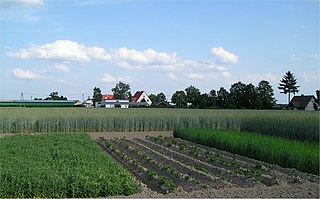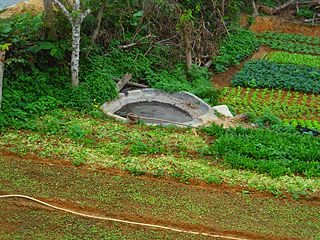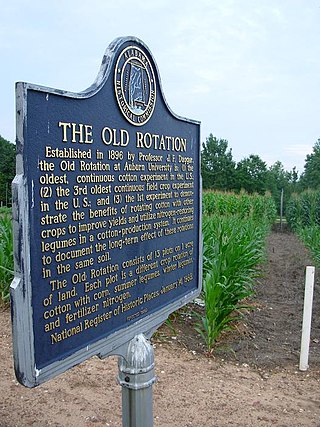
A fertilizer or fertiliser is any material of natural or synthetic origin that is applied to soil or to plant tissues to supply plant nutrients. Fertilizers may be distinct from liming materials or other non-nutrient soil amendments. Many sources of fertilizer exist, both natural and industrially produced. For most modern agricultural practices, fertilization focuses on three main macro nutrients: nitrogen (N), phosphorus (P), and potassium (K) with occasional addition of supplements like rock flour for micronutrients. Farmers apply these fertilizers in a variety of ways: through dry or pelletized or liquid application processes, using large agricultural equipment or hand-tool methods.

Crop rotation is the practice of growing a series of different types of crops in the same area across a sequence of growing seasons. This practice reduces the reliance of crops on one set of nutrients, pest and weed pressure, along with the probability of developing resistant pests and weeds.

Agronomy is the science and technology of producing and using plants by agriculture for food, fuel, fiber, chemicals, recreation, or land conservation. Agronomy has come to include research of plant genetics, plant physiology, meteorology, and soil science. It is the application of a combination of sciences such as biology, chemistry, economics, ecology, earth science, and genetics. Professionals of agronomy are termed agronomists.

In agriculture, rotational grazing, as opposed to continuous grazing, describes many systems of pasturing, whereby livestock are moved to portions of the pasture, called paddocks, while the other portions rest. Each paddock must provide all the needs of the livestock, such as food, water and sometimes shade and shelter. The approach often produces lower outputs than more intensive animal farming operations, but requires lower inputs, and therefore sometimes produces higher net farm income per animal.

A legume is a plant in the family Fabaceae, or the fruit or seed of such a plant. When used as a dry grain, the seed is also called a pulse. Legumes are grown agriculturally, primarily for human consumption, for livestock forage and silage, and as soil-enhancing green manure. Well-known legumes include beans, soybeans, chickpeas, peanuts, lentils, lupins, grass peas, mesquite, carob, tamarind, alfalfa, and clover. Legumes produce a botanically unique type of fruit – a simple dry fruit that develops from a simple carpel and usually dehisces on two sides.

In agriculture, a green manure is a crop specifically cultivated to be incorporated into the soil while still green. Typically, the green manure's biomass is incorporated with a plow or disk, as is often done with (brown) manure. The primary goal is to add organic matter to the soil for its benefits. Green manuring is often used with legume crops to add nitrogen to the soil for following crops, especially in organic farming, but is also used in conventional farming.

In agriculture, cover crops are plants that are planted to cover the soil rather than for the purpose of being harvested. Cover crops manage soil erosion, soil fertility, soil quality, water, weeds, pests, diseases, biodiversity and wildlife in an agroecosystem—an ecological system managed and shaped by humans. Cover crops can increase microbial activity in the soil, which has a positive effect on nitrogen availability, nitrogen uptake in target crops, and crop yields. Cover crops may be an off-season crop planted after harvesting the cash crop. Cover crops are nurse crops in that they increase the survival of the main crop being harvested, and are often grown over the winter. In the United States, cover cropping may cost as much as $35 per acre.

Plant nutrition is the study of the chemical elements and compounds necessary for plant growth and reproduction, plant metabolism and their external supply. In its absence the plant is unable to complete a normal life cycle, or that the element is part of some essential plant constituent or metabolite. This is in accordance with Justus von Liebig’s law of the minimum. The total essential plant nutrients include seventeen different elements: carbon, oxygen and hydrogen which are absorbed from the air, whereas other nutrients including nitrogen are typically obtained from the soil.

Nutrient management is the science and practice directed to link soil, crop, weather, and hydrologic factors with cultural, irrigation, and soil and water conservation practices to achieve optimal nutrient use efficiency, crop yields, crop quality, and economic returns, while reducing off-site transport of nutrients (fertilizer) that may impact the environment. It involves matching a specific field soil, climate, and crop management conditions to rate, source, timing, and place of nutrient application.

The history of agricultural science is a sub-field of the history of agriculture which looks at the scientific advancement of techniques and understanding of agriculture. Early study of organic production in botanical gardens was continued in with agricultural experiment stations in several countries.

Organic fertilizers are fertilizers that are naturally produced. Fertilizers are materials that can be added to soil or plants, in order to provide nutrients and sustain growth. Typical organic fertilizers include all animal waste including meat processing waste, manure, slurry, and guano; plus plant based fertilizers such as compost; and biosolids. Inorganic "organic fertilizers" include minerals and ash. The organic-mess refers to the Principles of Organic Agriculture, which determines whether a fertilizer can be used for commercial organic agriculture, not whether the fertilizer consists of organic compounds.

In agriculture, a living mulch is a cover crop interplanted or undersown with a main crop, and intended to serve the purposes of a mulch, such as weed suppression and regulation of soil temperature. Living mulches grow for a long time with the main crops, whereas cover crops are incorporated into the soil or killed with herbicides.
Agrogeology is the study of the origins of minerals known as agrominerals and their applications. These minerals are of importance to farming and horticulture, especially with regard to soil fertility and fertilizer components. These minerals are usually essential plant nutrients. Agrogeology can also be defined as the application of geology to problems in agriculture, particularly in reference to soil productivity and health. This field is a combination of a few different fields, including geology, soil science, agronomy, and chemistry. The overall objective is to advance agricultural production by using geological resources to improve chemical and physical aspects of soil.
A long-term experiment is an experimental procedure that runs through a long period of time, in order to test a hypothesis or observe a phenomenon that takes place at an extremely slow rate. What duration is considered "long" depends on the academic discipline. For example, several agricultural field experiments have run for more than 100 years, but much shorter experiments may qualify as "long-term" in other disciplines. An experiment is "a set of actions and observations", implying that one or more treatments is imposed on the system under study. Long-term experiments therefore contrast with nonexperimental long-term studies in which manipulation of the system studied is impossible or undesirable.

The Old Rotation is a soil fertility experiment on the Auburn University campus in Auburn, Alabama. The Old Rotation experiment, which started in 1896, is the third-oldest ongoing field crop experiment in the United States and the oldest continuous cotton experiment in the world. It was the first experiment to show that a cotton/legume crop rotation would allow soil to support a cotton crop indefinitely. The Old Rotation is listed on the National Register of Historic Places.

A biofertilizer is a substance which contains living micro-organisms which, when applied to seeds, plant surfaces, or soil, colonize the rhizosphere or the interior of the plant and promotes growth by increasing the supply or availability of primary nutrients to the host plant. Biofertilizers add nutrients through the natural processes of nitrogen fixation, solubilizing phosphorus, and stimulating plant growth through the synthesis of growth-promoting substances. The micro-organisms in biofertilizers restore the soil's natural nutrient cycle and build soil organic matter. Through the use of biofertilizers, healthy plants can be grown, while enhancing the sustainability and the health of the soil. Biofertilizers can be expected to reduce the use of synthetic fertilizers and pesticides, but they are not yet able to replace their use. Since they play several roles, a preferred scientific term for such beneficial bacteria is "plant-growth promoting rhizobacteria" (PGPR).

Abdul Rashid, is a Pakistani agricultural scientist, who has served as a Member (Bio-sciences) of the Pakistan Atomic Energy Commission (PAEC) from 2008 to 2011 and Director General of Pakistan's National Agricultural Research Center (NARC) from 2006 to 2008. He received a Ph.D. from the University of Hawaii at Manoa, Hawaii, in the United States.

Base-cation saturation ratio (BCSR) is a method of interpreting soil test results that is widely used in sustainable agriculture, supported by the National Sustainable Agriculture Information Service (ATTRA) and claimed to be successfully in use on over a million acres (4,000 km2) of farmland worldwide. The traditional method, as used by most university laboratories, is known variously as the 'sufficiency level', sufficiency level of available nutrients (SLAN), or Index(UK) system. The sufficiency level system is concerned only with keeping plant-available nutrient levels within a well studied range, making sure there is neither a deficiency nor an excess. In the BCSR system, soil cations are balanced according to varying ratios often stated as giving 'ideal' or 'balanced' soil. These ratios can be between individual cations, such as the calcium to magnesium ratio, or they may be expressed as a percentage saturation of the cation exchange capacity (CEC) of the soil. Most 'ideal soil' theories stress both approaches.

William Albert Albrecht chairman of the Department of Soils at the University of Missouri, was the foremost authority on the relation of soil fertility to human health and earned four degrees from the University of Illinois at Urbana–Champaign. As emeritus professor of soils at the University of Missouri, he saw a direct link between soil quality, food quality and human health. He drew direct connections between poor quality forage crops, and ill health in livestock and from this developed a formula for ideal ratios of cations in the soil, the Base Cation Saturation Ratio. While he did not discover cation exchange in the soil as is sometimes supposed, he may have been the first to associate it with colloidal clay particles. He served as 1939 President of the Soil Science Society of America.
Twenty years before the phrase 'environmental concern' crept into the national consciousness, he was lecturing from coast to coast on the broad topic of agricultural ecology.
" The soil is the ‘creative material’ of most of the basic needs of life. Creation starts with a handful of dust.” Dr. William A. Abrecht.

The Magruder Plots are experimental winter wheat field plots at Oklahoma State University established in 1892. They are the third longest-running such field trial in the United States, following the Morrow Plots established in 1876 at the University of Illinois at Urbana–Champaign, and the Sanborn Field established in 1888 at the University of Missouri. They are examples of long-term experiments.






















